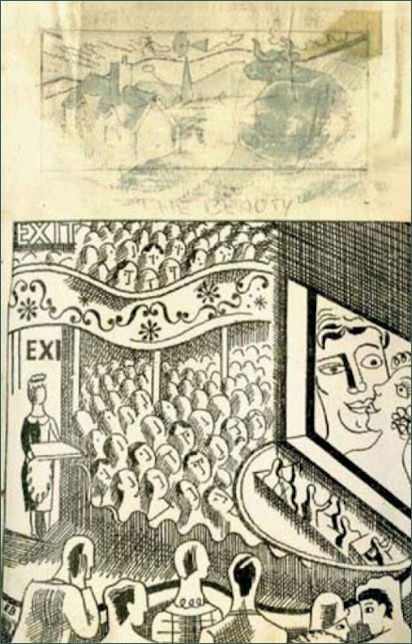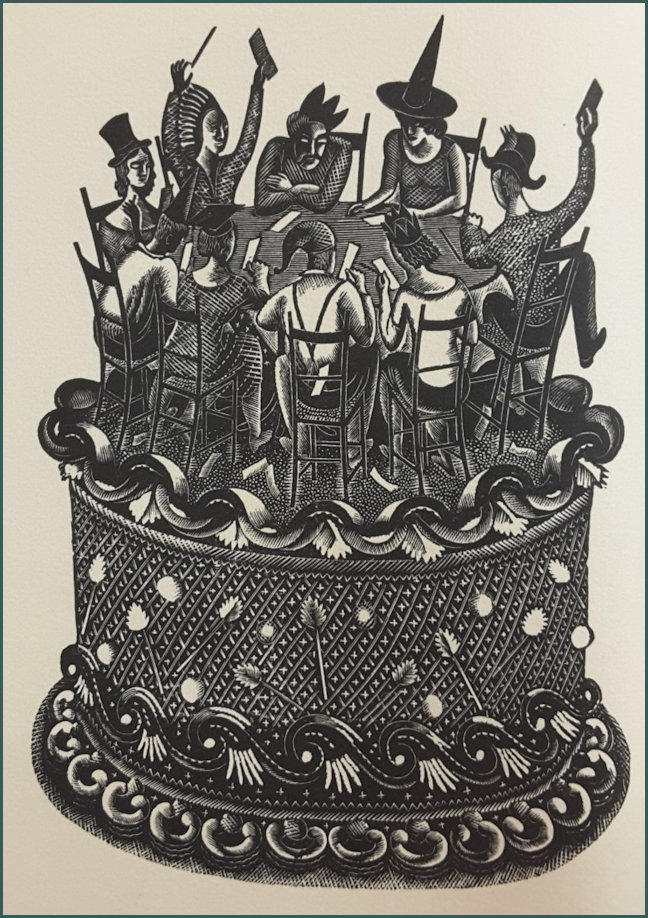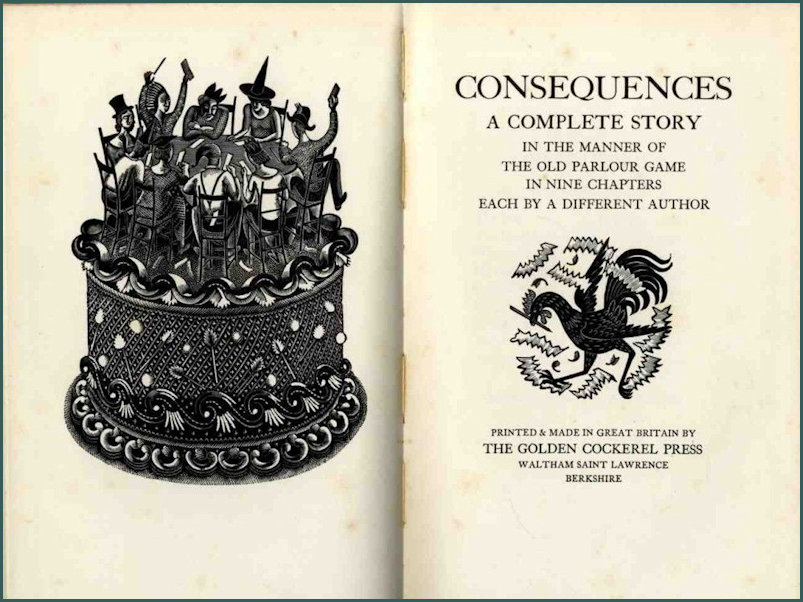Art Deco - Curios
Art Deco - Dolls houses
Looks like this was a popular hobby judging by the up-to-the-minute design for a 1930s 'Sun House' dolls' house on this W. Paine & Co's Christmas catalogue page (Chatham, Kent c.1937) - starting price 6/11d! Image sourced via Flickr
This beautifully crafted Doll's House is an exact replica in miniature of a house in Kensington - see more at dollshousespastandpresent.com it's a real treat for Art Deco and Doll's Houses enthusiasts!
An unidentified 1937 property in miniature - image sourced from nanasminis.com another fine example of the front and rear of a beautifully scaled down model in quite a contrasting style to the Kensington property
Eric ravilious - Scrapbook
The remarkable scrapbooks of Eric Ravilious
Peyton Skipwith thought he had seen the complete works of Eric Ravilious – until he found two lost scrapbooks made for his lovers - The Oldie 1st September 2018

"A scrapbook page: 1 Little Red Riding Hood, a 19th-century children's book; 2 Rose and acorn study for 1935 Jubilee pattern engraving; 3 Design for Ravilious's Wedgwood ceramics; 4 Sketch for Poems by Thomas Hennell (1936), of a girl at Lady Maynard's tomb, Little Easton Church, near Ravilious's Essex home; 5 Sketch for a Hennell poem, Garden Memories. The other two drawings are mysteries"
When Brian Webb and I started on the project of editing Eric Ravilious's scrapbooks last year, it seemed a relatively straightforward project. They belong to the Fry Art Gallery in Saffron Walden, along with Edward Bawden's scrapbooks, which we had edited in 2016. In addition to the scrapbooks, we also had the three volumes of Ravilious's correspondence, as well as the memoir of his widow, Tirzah Garwood, Long Live Great Bardfield, and plenty of other material. The letters first warned us that our task wasn't going to be as straightforward as we had originally thought. Or as thrilling. None of the scrapbooks had been published before, and now we found there were two lost scrapbooks. Two letters set alarm bells ringing: one to Helen Binyon, Ravilious's lover and daughter of the poet Laurence Binyon (as in For the Fallen – 'They shall grow not old, as we that are left grow old'); the other to another lover, Diana Tuely. The one to Binyon, written in June 1936 when their love affair was at its most intense, refers to a little scrapbook he had made specially for her, 'with loving care and all the odd things I thought you should like'. The other, written on 2nd January 1939 to Tuely was to thank her for various Christmas presents, including a little Russian book, which his son John had liked: 'Tirzah this evening stuck it into our New Year Album.'
These references immediately posed the question, 'Do these two albums still exist and, if so, where are they?'
It proved relatively easy to find the New Year Album – a late Victorian scrapbook, bearing the rather baffling title label 'Monkeyana' – as it was still in the family, having always been regarded as Garwood's rather than Ravilious's. As the letter to Tuely showed, it was by way of being a collaborative venture, even if it was Garwood's hand that wielded the glue brush. We eventually traced the small scrapbook for Helen Binyon to the East Sussex Record Office. Fortunately, these two letters had been included in the published correspondence, prompting me to joke that I might one day write an article called 'Thank God for Artists' Mistresses'. The little book he made for Binyon is a delight and, in our new book, we have illustrated it almost in its entirety. It is in reality a small exercise book – not a traditional scrapbook – and was compiled as an entity rather than in traditional scrapbook mode. It is part rebus and part extended love letter, everything being chosen with particular care for its resonance. Looking through it 80 years on, some of the coded messages are lost in the mists of time and are indecipherable. What did Eric mean when he wrote of this scrapbook, 'A few of the pages are in bad taste – as the one opposite the Blakes'? The page in question has a reproduction of a mid-16th-century engraving of Concordia with her arm draped over a millstone, below which Eric wrote, 'Figure has a living personality, while girl standing with her bicycle is a charming achievement.'
In contrast, other images, such as Bawden's London Underground cinema advertisement, with an exaggerated screen image of an amorous couple, and the façade of the British Museum, inscribed 'very attractive residence', need no explanation – beyond the knowledge that Laurence Binyon, keeper of prints and drawings, had an official residence in the museum precinct. Ravilious's main scrapbooks at the Fry are divided between a somewhat haphazard record of his own work, with particular concentration on wood engravings, illustrations and designs, on the one hand, and newspaper and magazine cuttings, on the other. The latter were preserved purely for reference. Even as a student at the Royal College of Art, Ravilious had been described as sifting 'with the skill of an anthologist the rare things that could help him in his work'. He carefully preserved articles such as those with reproductions of medieval tapestries, which find echoes both in his Morley College murals, and his illustrations for the Golden Cockerel Press edition of Twelfth Night. There are also press cuttings of balloons, aeroplanes and firework displays. The latter held a strong fascination for him and found expression in the mural he painted for the Midland Hotel, Morecambe, as well as in one of his most famous watercolours, November 5th 1933. He also preserved a quantity of press images of tennis players, which helped him capture the balletic gestures of the players in the three tennis panels he painted for Sir Geoffrey Fry, Stanley Baldwin's private secretary, which are now in Bristol City Art Gallery. Living at Castle Hedingham, Essex, he needed a ready source of reference material for, as Binyon wrote in her biography, his 'day's activity could be decided by the morning's post'. This could bring requests from the Curwen Press, wanting engravings for clients, ranging from the Southern Railway and Green Line Buses, to a Hamburg hatter wanting an 'artist experienced in drawing hat stamps'.

Top Ravilious picture for 'Consequences' (1932); above his drawing for a Green Line Buses advert (1936) over a London Underground advert by Edward Bawden
These were mostly run-of-the-mill jobs, which provided his bread and butter, but they had to be turned round at great speed. Fortunately, in those days, the post was quicker than today's. Designs and engravings not only needed to be done but proofs had to be sent for approval and duly returned before the job could be completed. The principal scrapbook at the Fry – like 'Monkeyana', a gaudy Victorian one with the embossed title 'Ferns', making the manufacturer's intention for its use quite clear – contains proof engravings, drawings and tracings. Ferns has Ravilious's hand-coloured frontispiece for Consequences (1932, pictured opposite) – a version of the parlour game, where nine authors, including Elizabeth Bowen, each wrote a chapter. The writers are drawn playing Consequences on top of a gaudy cake. Pictures are scattered haphazardly throughout the albums, with many of the drawings torn, as if he were in two minds whether to throw them away. Decoding the scrappier pieces and relating them to finished works (as in the Blue Ryman's scrapbook, pictured left) has been a labour of love. In a 1936 letter to Binyon, Ravilious described how he decided to remake his scrapbooks: 'They badly needed an overhaul and new material. They have no beauty of any sort and very little order – they are simply useful.' He went on to contrast them with Bawden's, which he described as marvels of 'industry and cunning, fit for a museum'.
When Brian and I edited the Bawden scrapbooks, it was possible to reproduce entire pages untouched but, with the Ravilious albums, we have had to regroup a lot of material in order to put it in context and make sense of it. Ravilious complicated this progressive sequence. He recycled designs – the same motif or figure crops up repeatedly in murals from the 1920s, and then again in watercolours, wood engravings and Wedgwood ceramics (pictured above left) from the following decade. An extreme case is A Cross to Airmen, originally engraved in 1933 as an illustration to Martin Armstrong's Fifty-four Conceits and reused three years later in Poems by Thomas Hennell. The picture made a final appearance on the Wedgwood 'Travel' dinner service – designed in 1938 and not issued until 1952, ten years after Ravilious's death, aged 39, in an RAF plane, lost in Iceland in 1942*.
A unique hand-coloured proof of the frontispiece for 'Consequences', 1932 the last book Ravilious illustrated for Robert Gibbings at the Golden Cockerel Press : sourced from bibliocloudimages


" ‘Consequences: A Complete Story in the Manner of the Old Parlour Game in Nine Chapters Each by a Different Author’. The first edition consisted of 200 numbered copies on hand made paper signed by the authors and illustrator. There was also an edition of 1000 copies. Pattern paper boards. Leather spine with title in gilt. Some wear to the top and bottom of the spine - Images and dialogue sourced from pallantbookshop.com with thanks
A unique hand-coloured proof of the frontispiece for 'Consequences', 1932 the last book Ravilious illustrated for Robert Gibbings at the Golden Cockerel Press : sourced from bibliocloudimages
He was never one to waste a good image.
* "Of all the official war artists employed by Britain during the Second World War few can be said to have derived more inspiration and benefit from the experience in purely aesthetic terms than Eric Ravilious (1903-42). Sadly, his participation in the war cost him his life. In September 1942 he accompanied a search and rescue mission in a Hudson aircraft of RAF Coastal Command that left its base in Iceland to look for comrades whose aircraft had disappeared the previous day. He too was presumed killed when the plane went missing and no trace of it was found. But in the three years before his death, Ravilious recorded many remarkable scenes and events, mostly involving warships, aircraft and coastlines, as though in a strange prefiguration of his own death. One of his most haunting paintings, HMS Glorious in the Arctic (1940) shows the aircraft carrier shortly before her loss in tragic and controversial circumstances on June 8th, 1940. Seventy years later this painting serves as a powerful memorial to the sailors and airmen lost with her." - Source : historytoday.com
Page created : 17th June 2020 (G)